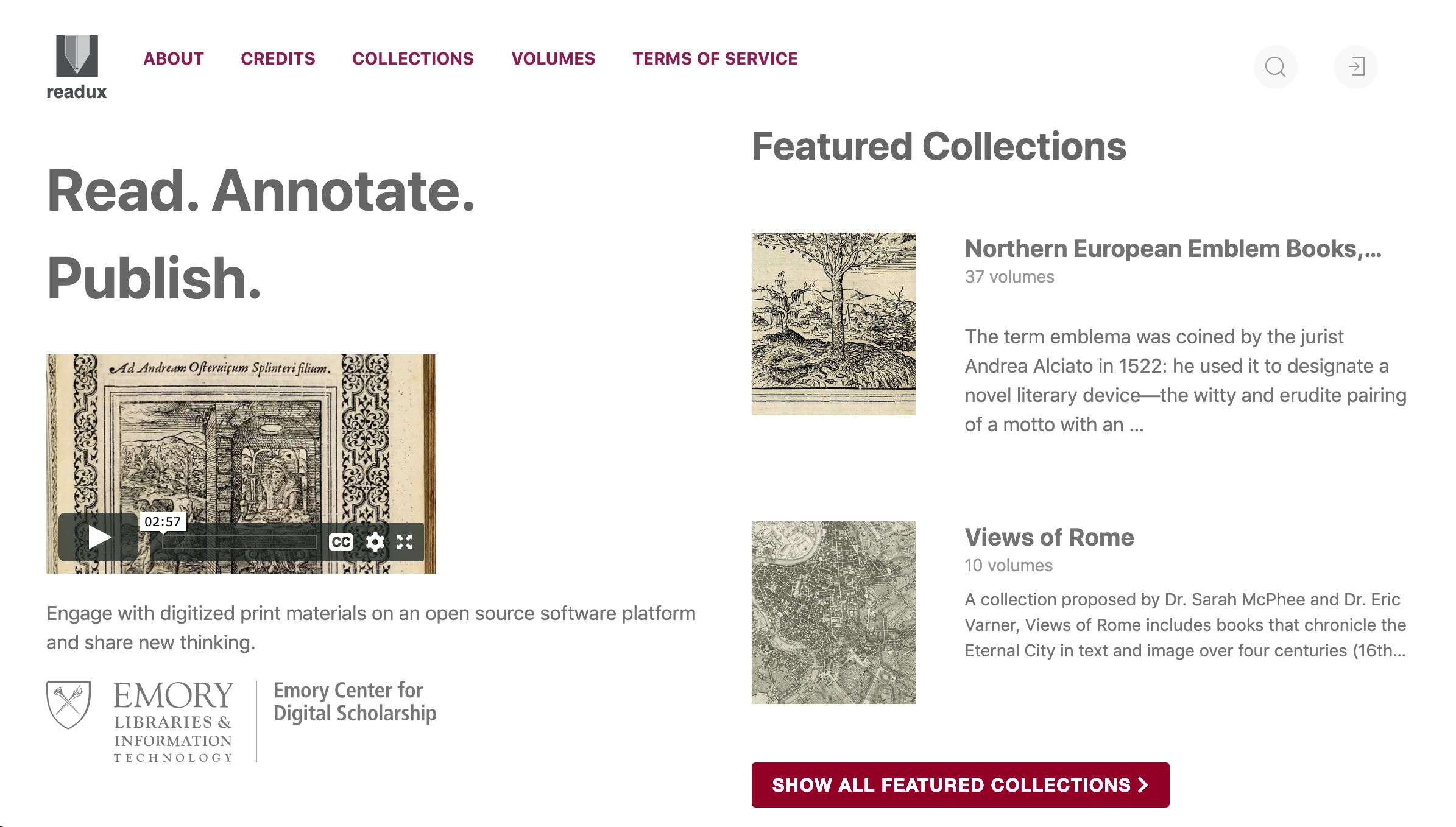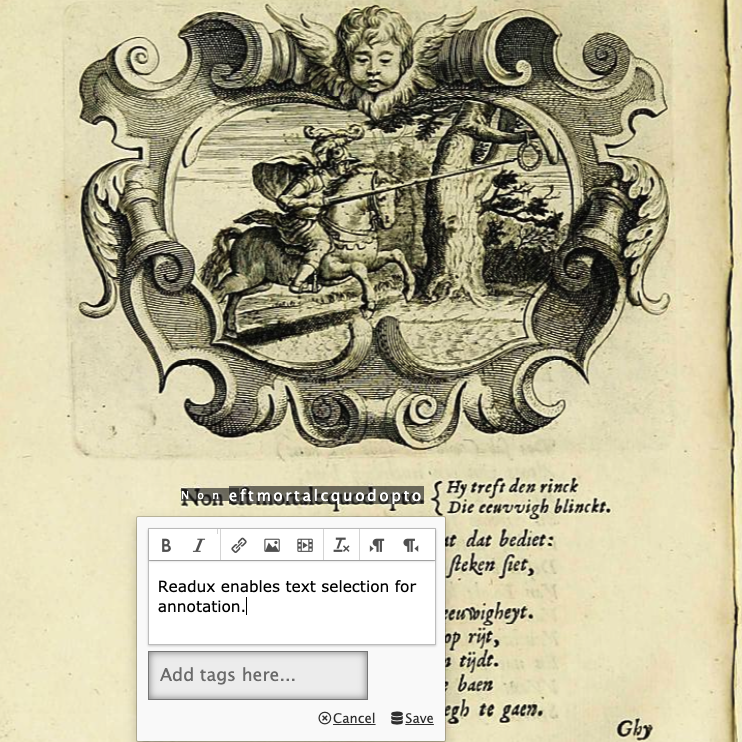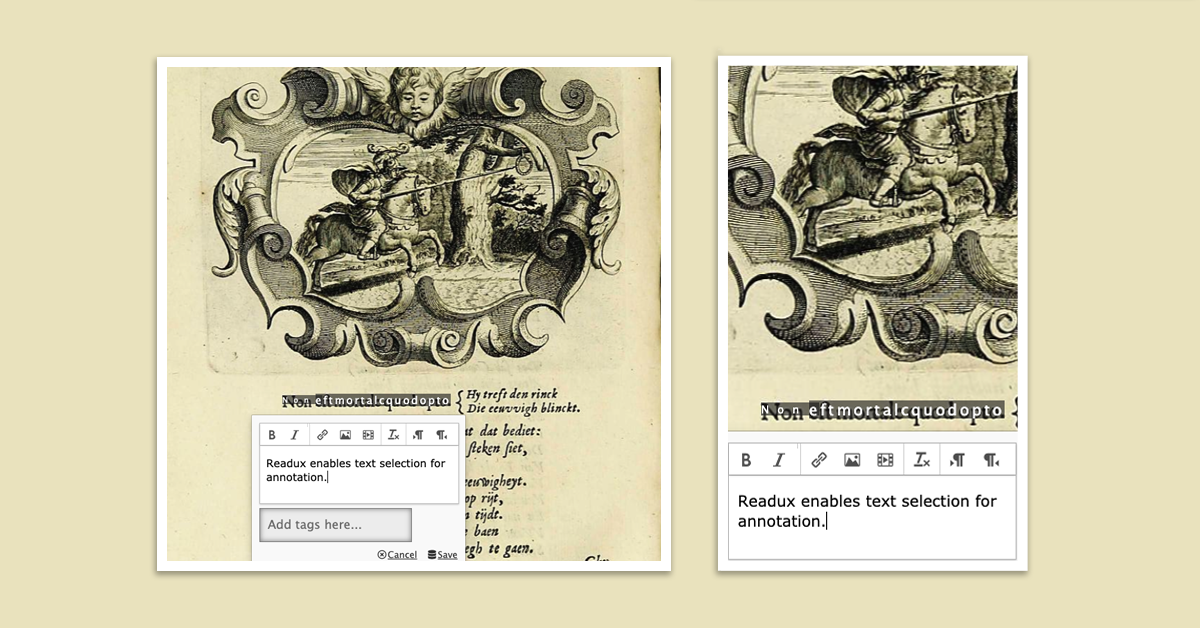The Emory Center for Digital Scholarship (ECDS) is pleased to announce the launch of Readux 2, a pioneering platform for browsing, taking notes, and teaching or publishing with digitized books. Building on the success of Readux 1, this new version has enhanced features that improve the ability of scholars to engage with a wide variety of content. You can use Readux 2 in your teaching or adopt it at your institution. We invite you to get in touch via email at: ecds [at] emory [dot] edu.
- Link to Readux 2: https://readux2.ecdsdev.org/

Readux has been developed by ECDS as a way to aggregate and organize thematic collections of digitized books so that users can browse, annotate, and publish with them. Readux’s easy-to-use annotation and export tools for teaching and publishing—and its framework that allow site administrators to create collections highlighting thematically-connected volumes—differentiate the platform from large-scale repositories like the Internet Archive and the Emory University-partnered HathiTrust or highly customized digital thematic collections. Site visitors can access machine-readable text that is invisibly overlaid on the books’ page images and add notes to the text or regions of the page. An annotated book can be exported as a free-standing, customizable website suitable for class projects and publications.
ECDS developed Readux 2 in order to make the platform compatible with a larger range of content than is available in Readux 1. While Readux 1 is bound to volumes in Emory University’s repository, Readux 2 sites can incorporate books and images from institutions around the world. This enables ECDS—or others deploying Readux 2—to bring together thematic collections from a diverse selection of libraries.
Readux 2’s ability to pull content from other institutions is made possible by an image-sharing technology known as the International Image Interoperability Framework (IIIF). IIIF’s standards establish pathways to share images and data about images so that visual resources can be easily accessed across platforms. By using IIIF, Readux 2 sites can accept materials already hosted on the web at the Internet Archive and dozens of other institutions publishing IIIF data.
In addition to a wider content base, several features distinguish Readux 2 from its predecessor. Deep zoom and annotation functions have been enhanced so that users can zoom into tight portions of a page and annotate the image or text at a close level. This allows for increased precision in examining and interacting with digitized works. Readux 2 also benefits from a newly-streamlined, mobile-friendly user interface and Mirador, a popular IIIF content viewer that ECDS has customized to extend saving and export functionality.

The Readux 2 platform has been adopted by the Sounding Spirit Digital Library, which features songbooks and hymnals published across the southern United States from 1850 to 1925 from the collections of four leading archives. (You can read more about the launch of the digital library in our blog post from May 2020.) The ECDS Readux 2 website features various collections of books, including 37 emblem books published in Northern Europe between 1550 and 1700 as well as 31 flight data files from the 1971 Apollo 15 mission provided by astronaut Colonel David R. Scott. These invaluable works are used by faculty at Emory to prompt students to comment on primary sources and make connections between pages in a work and other resources.
The project team is actively developing Readux with new features planned for the upcoming year. ECDS will make it faster and easier to ingest books into the platform and make it possible for groups of users to collectively annotate works together. These planned enhancements will bolster the adoption of Readux in classrooms at Emory University and beyond.
We invite you to use Readux in your own teaching and research and to get in touch with us about how the platform could better serve your needs:
- Learn more. View the “ECDS Tools for Teaching” workshop and learn how to use Readux in your teaching. The recorded workshop is available on the ECDS Workshops Canvas page. Contact us at ecds [at] emory [dot] edu to be added to the free Canvas site.
- Use it in your classes. You can use any of the works in ECDS’s Readux 2 collections or in the Sounding Spirit Digital Library in your class this Fall. Teachers and students anywhere can access either site’s annotation and export features by logging in through their own Gmail, Facebook, GitHub, or Twitter account(s).
- Add works for your own research and teaching. Contact us (ecds [at] emory [dot] edu) if there are primary source materials you would like to be added to the site so that you can annotate and publish with them.
- Use Readux at your own institution. If there are collections at your institution that would benefit from Readux’s functionality, please get in touch. We are seeking partners interested in adopting the software.
- Submit feedback. As an ongoing project, we welcome feature requests for future releases of the software.
Readux offers a wealth of possibilities for engaging with digitized works. We look forward to continuing its development for a global audience.
